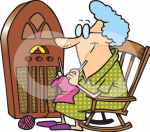Amateur
Radio Telegraphy Tests on Shortwave
Amateur radio operators are credited with the discovery of long-distance
communication on the shortwave bands. Early long-distance services used surface wave propagation at very low frequencies,
which are attenuated along the path. Longer distances and higher frequencies using this method meant more signal attenuation.
This and the difficulties of generating and detecting higher frequencies, made discovery of shortwave propagation difficult
for commercial services.
Radio amateurs conducted
the first successful transatlantic tests in December 1921, operating in the 200 metre mediumwave
band (1500 kHz) - the shortest wavelength then available to amateurs.
In 1922 hundreds
of North American amateurs were heard in Europe on 200 metres and at least 20 North American amateurs heard amateur signals
from Europe. The first two-way communications between North American and Hawaiian amateurs began in 1922 on 200 metres.
Although
operation on wavelengths shorter than 200 metres was technically illegal (but tolerated as the authorities mistakenly believed
at first that such frequencies were useless for commercial or military use), amateurs began to experiment with those wavelengths
using newly available vacuum tubes shortly after World War I.
Extreme interference at the upper edge of the 150-200 metre band - the official
wavelengths allocated to amateurs by the Second National Radio Conference in 1923 - forced amateurs to shift to shorter and shorter wavelengths; however,
amateurs were limited by regulation to wavelengths longer than 150 metres (2 MHz). A few fortunate amateurs who obtained
special permission for experimental communications below 150 metres completed hundreds of long distance two way contacts on
100 metres (3 MHz) in 1923 including the first transatlantic two way contacts.in November 1923, on 110 metres (2.72 MHz)
By 1924 many additional specially
licensed amateurs were routinely making transoceanic contacts at distances of 9600 km and more. On September 21 several amateurs
in California completed two way contacts with an amateur in New Zealand. On October 19 amateurs in New Zealand and England
completed a 90-minute two-way contact nearly halfway around the world.
On October 10, the Third
National Radio Conference made three shortwave bands available to U.S. amateurs at 80 metres (3.75 MHz),
40 metres (7 MHz) and 20 metres (14 MHz). These were allocated worldwide, while the 10-metre band (28 MHz) was created by the Washington International
Radiotelegraph Conference on November 25 1927.
The 15-metre band (21 MHz) was opened to amateurs in the United States on May
1 1952.
In June and July 1923, Guglielmo Marconi's transmissions
were completed during nights on 97 metres from Poldhu Wireless Station, Cornwall, to his yacht Elettra in the Cape Verde Islands.
In September 1924, Marconi transmitted during daytime and night-time on 32 metres from Poldhu to his yacht in Beirut.

